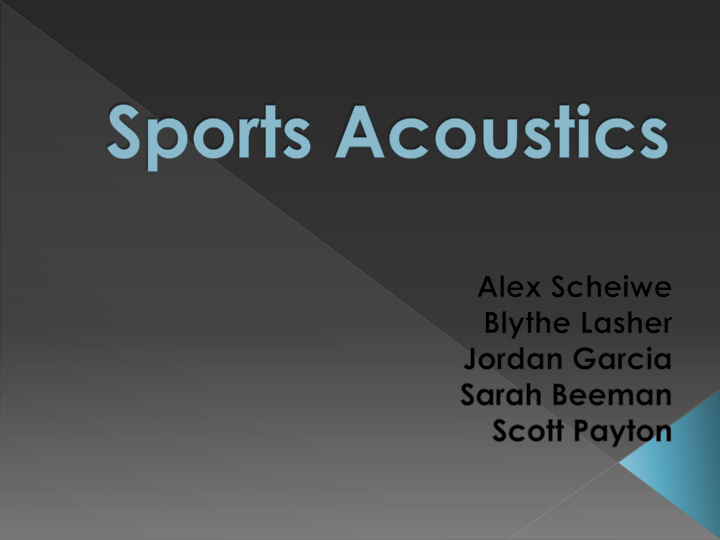



National Anthem Aluminum and Composite Bats Basketball Home Field Advantage
Pros Cons › Larger crowd, better › Venue not suited for atmosphere performance › Performer satisfaction › Outside factors › Speakers face › Unpredictability of audience speakers › Lack of smoothness
Pros Cons › Structure › Performance › Clarity and satisfaction smoothness › Speaker deficiency › Envelopment › Microphone sensitivity
Aka: metal, alloy bats Make a “ping” sound
Interconnected, woven fibers
Sales have taken off in the last five years Produce a trampoline effect › Like a spring that compresses Don’t have modes or nodes Make virtually the same sound up and down the bat, as long as the ball is squared up › Any difference in sound is from how straight on the ball hits the bat › Makes a “thud” sound Some are now illegal to use
http://www.youtube.com/watch?v=YIHK OPeWFg0
The decibel is the unit used to measure the intensity of a sound. › Your ears can hear everything from your fingertip brushing lightly over your skin to a loud jet engine. › In terms of power, the sound of the jet engine is about 1,000,000,000,000 times more powerful than the smallest audible sound.
The amount of energy that is transported past a given area of the medium per unit of time is known as the intensity of the sound wave. The greater the amplitude of vibrations of the particles of the medium, the greater the rate at which energy is transported through it, and the more intense that the sound wave is.
Many fans believe that while the visiting team is shooting free throws they can have a great impact in the outcome of the game. Many games are lost by just a few points. It is during the free throws that visiting players can hear the fans the most. Some studies have been done to research if certain variables such as point margins, pre- shot routines, and audience participation affect free throw accuracy.
Method to the Study: POSES TWO QUESTIONS: A LabQuest handheld device with a sound Does decibel level affect level meter attached the free throw accuracy was used to record of visiting teams? these measurements.(3 games all at BYU Marriot Center) Does the maximum BYU vs. Gonzaga decibel level before the BYU vs. Pepperdine shot or the average BYU vs. Portland decibel level before the All measurements were shot matter most? recorded from center court- 28 rows up in the student section
Maximum dB reading of 97
The data shows that the average of the maximum and mean decibel levels for the made shots was about six decibels higher than that of the missed shots. The results were the opposite of what I had expected: › that a visiting player is more likely to score a free throw if either the max or mean decibel level is increased before he takes the shot. Why these results?
During the game: Kansas fans sound levels reach 122 dB As we have learned exposure to a › decibel level of 110 for more than a minute and a half can cause damage to someone's hearing Throughout the game, Allen › Fieldhouse consistently hit noise levels of 90-100. "I would have to say that I've played a lot of places and this is one of the loudest. They have great fans and it seems to give us an extra boost," Georgia Tech junior guard Jarrett Jack said. With so much noise the players, the › opposing team can’t distinguish the different insults or chants against them. It’s as if they have headphones on › playing “white noise” at a high volume.
Exposure to high levels of noise like at a College basketball game may cause hearing loss, create physical and psychological stress, reduce productivity, interfere with communication, and contribute to accidents and injuries by making it difficult to hear warning signals. Exposure to loud noise will inevitably cause hearing loss over time. Loud noise damages or destroys the hair cells in the inner ear. Another effect can be “tinnitus” or permanent ringing in the ear.
The table below shows noise levels and how long a person can be exposed without hearing protection before there is damage to the ear. Noise Level Allowable Exposure Time The average basketball game is around 85 decibels 8 hours 2 hours long (accounting for timeouts, quarter breaks and half time) 90 decibels 4 hours Based off the study, the average 100 decibels 1 hour decibel reading was in between 90 and 105 decibels 30 minutes 100 dB. 110 decibels 15 minutes As proved in the study at BYU, the loudness of the fans throughout the 115 decibels 0 minutes game does not impact the shooting percentage however, does increase the probability of everyone in the arena to leave the game with hearing loss.
From small gymnasiums to large arenas, almost inadvertently they are designed to amplify sound. They are reverberation chambers. Therefore they amplify sound more than they might have otherwise. › The problem is that the intensity level at some basketball games can permanently damage hearing. "When you combine all the noise that we listen to during a basketball game, the intensity of that noise - - from the pep band to the crowd, the PA system -- can reach levels that are damaging to our hearing up to around 115 decibels. At that intensity level, we can stand that noise without permanent damage to our hearing for approximately seven and a half minutes .“ – Wichita State University audiologist Ray Hull
http://www.youtube.com/watch?v=iaW J6Np4a00
http://www.physics.usyd.edu.au/~cross/ baseball.html http://www.acs.psu.edu/drussell/bats/co mpalum.html http://www.cstv.com/sports/m- baskbl/uwire/010305aaj.html http://www.wichita.edu/thisis/wsunews/ news/?nid=1972 http://www.et.byu.edu/~kuhndog/Journ alArticle.pdf
Recommend
More recommend